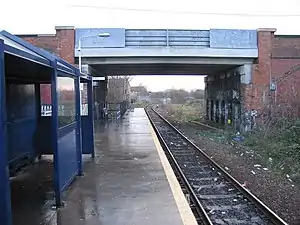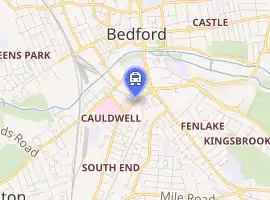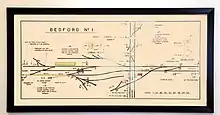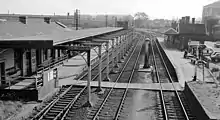Bedford St Johns railway station
Bedford St Johns is one of two railway stations in Bedford in Bedfordshire, England, on the Marston Vale Line linking Bletchley and Bedford. It is unstaffed and is operated by London Northwestern Railway.
 The station, looking south | |
| Location | Bedford, Bedford England |
| Coordinates | 52.1294°N 0.4677°W |
| Grid reference | TL049490 |
| Managed by | London Northwestern Railway[1] |
| Platforms | 1 |
| Other information | |
| Station code | BSJ |
| Classification | DfT category F2 |
| Key dates | |
| 18 November 1846 | Opened as "Bedford" |
| 2 June 1924 | Renamed "Bedford St Johns" |
| 1 January 1968 | Closure of Oxford to Cambridge line |
| 15 July 1968 | Closed to freight and became unstaffed halt |
| 14 May 1984 | Resited |
| Passengers | |
| 2015/16 | |
| 2016/17 | |
| 2017/18 | |
| 2018/19 | |
| 2019/20 | |
| Location | |

| |
| Notes | |
Passenger statistics from the Office of Rail and Road | |
St Johns was Bedford's first station, on the Oxford to Cambridge line. Its role diminished following the closure of that line, leaving it with a truncated route to Bletchley. British Rail closed the original station on 14 May 1984 and diverted services from Bletchley along a new chord line to Bedford Midland station when a new bay platform was opened.
Services
The station is served by London Northwestern Railway local services from Bletchley to Bedford via the Marston Vale Line, using Class 230 multiple units.
Monday to Saturdays, there is generally an hourly service to Bletchley (westbound) and to Bedford Midland (eastbound) with no Sunday service.[2]
| Preceding station | Following station | |||
|---|---|---|---|---|
| London Northwestern Railway Mondays-Saturdays only |
Community Rail Partnership
In common with others on the Marston Vale Line, the station is covered by the Marston Vale Community Rail Partnership,[3] which aims to increase use of the line by involving local people.
History
Opening
The station was opened in November 1846 by the Bedford Railway as the eastern terminus of its line from Bletchley, the first line to reach the town.[4] The station was on the west side of the A600 London Road (grid reference TL 052 489), with the main station buildings on the south side of the line facing the public house. The goods yard was further west nearer the River Great Ouse to receive river traffic. A second connecting line to the goods yard created a triangle which diverted drainage to produce a pond which supplied the station and small two-road locomotive shed.[5]
1875 Accident

A second station was opened in Bedford in 1857 on the Midland Railway's Leicester to Hitchin line. The route chosen by the Midland took it across the earlier line at a point near the Bletchley end of the triangle, and a level crossing was built. In March 1875, a Midland passenger train collided with the rear coaches of a Bedford service, killing one passenger and injuring four others. The subsequent enquiry identified a badly-positioned Bedford starter signal as a major cause of the accident. To remedy the problem a 29-lever signal box was opened in 1877 to control new interlocked signals, and block signalling was introduced throughout the Bedford line, which had been extended to Cambridge.[6]
Decline and relocation


_2018.jpg.webp)
Although the Second World War saw the Oxford-Cambridge line handle unprecedented levels of traffic, it suffered from a lack of investment in the post-war years. The 1955 Modernisation Plan proposed improvements to the line, believing it could be a strategic cross-country route for freight across three British Railways regions without having to pass through London. The policy was however to change within a few years, leaving the Bletchley Flyover as a testament of the change of course. The first attempt to close the line came in 1959, but was unsuccessful in the face of local opposition. Hopes for the line thereafter rose when it did not figure in the Beeching Report, but it was nevertheless proposed for closure in 1964, with the Oxford — Bletchley and Bedford — Cambridge routes closing after the last day of service on 30 December 1967.[4]
The Bletchley - Bedford route, now known as the Marston Vale Line, survived in a downgraded form as freight facilities were withdrawn and the stations became unstaffed halts. The station, now a terminus, came under the authority of then area manager at Bedford Midland. By March 1971 the main station buildings and water tower had been demolished, leaving it as a terminus halt.[7] A third attempt to close the line in 1972 was resisted by the Bedford Rail Users' Association.
In 1984, a replacement station was opened in the former freight yard, at the north end of the triangle, which enabled services to continue to Bedford Midland. The new connection runs over the route of the Midland's Hitchin line, which closed in 1964.[8] The old station site was abandoned, although some of the furniture, such as the lampposts, was not removed. The site has now been reclaimed by nature.[9][10]
| Preceding station | Disused railways | Following station | ||
|---|---|---|---|---|
| Kempston and Elstow Halt | British Railways Varsity Line |
Willington |
Future
East West Rail is seeking to reinstate the entire Oxford to Cambridge route. Following a consultation process in 2019, the Company's preferred route between Bedford and Cambridge continues to use the current route via St Johns onto the Midland Main Line, then north via Bedford Midland before turning east towards Tempsford (rather than following the old Varsity Line alignment through the original Bedford St Johns station site).[11]
References
- "National Rail Enquiries - Station facilities for Bedford St Johns". www.nationalrail.co.uk.
- Table 64 National Rail timetable, May 2016
- Marston Vale Community Rail Partnership
- "Disused Stations: Bedford Railway". www.disused-stations.org.uk.
- Simpson 1981, p. 74.
- Simpson 1981, p. 78.
- Simpson 1981, p. 148.
- Crane, R. (13 May 2002). "The Oxford to Cambridge Line - Then and Now". The Friends of the National Railway Museum. Archived from the original on 2 August 2007.
- Catford, Nick (29 June 2012). "Disused Stations site record". Station Name: Bedford St. Johns.
- "Bedford St Johns". Subterranea Britannica. 23 April 2007.
- "Connecting Communities: The Preferred Route Option between Bedford and Cambridge Executive Summary" (PDF). eastwestrail.co.uk. Retrieved 27 October 2020.
Sources
- Simpson, Bill (1981). Oxford to Cambridge Railway. Poole: Oxford Publishing Co. p. 74. ISBN 0-86093-121-8.
External links
| Wikimedia Commons has media related to Bedford St Johns railway station. |
- Train times and station information for Bedford St Johns railway station from National Rail